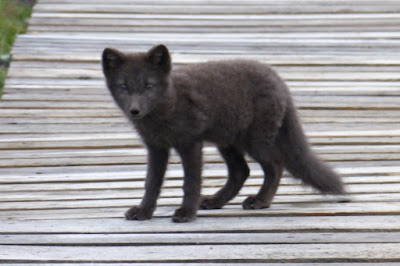The first half of July 22nd was documented in the previous post. Now we pick up the second half.
Leaving Djúpivogur we followed the Ring Road along the shore of Berufjörður to its end, and then left the Ring Road on a hard-packed but unpaved road towards Öxi pass. Started in 1959 by a local man,
and now officially route 939, it was a fraction of the distance demanded by following the Ring Road down the far side of the fjord and around the coast before turning inland. Partway up we pulled over for our lunch stop at the Foldafoss waterfall.
It was blustery and cold. We ventured to the edge of the waterfall, but most went no further.
Looking closer ... click on the image to enlarge ... a small figure at bottom left of center shows it's further away than it looks.
We ate our lunch inside the van, out of the wind. Then continuing north we rejoined Route 1 and kept on to the Vallenes farm, home of the Móðir Jörð (Mother Earth) line of organic Icelandic products.
The farm is famous for, among other things, being the first and only farm in Iceland to grow barley. It was as necessary to convince Icelandic restaurants and groceries to carry the barley as it was to grow it. The barley in one of our Omnom chocolate bars purchased in Reykjavik came from here.
The pioneer owner, Eymundur Magnússon,
gave our small group a tour. First, the greenhouse.
A view of some of the fields. Note all the trees here and on the near horizon: Eymundur planted over one million trees on this property, despite some neighbors complaining that they spoiled the view.
Netting, depending on the type, is used for different purposes. It can keep the one insect pest, a fly, off the green leafy vegetables such as kale. For potatoes, a light permeable cloth can protect the crop against the occasional August frost, extending the growing season. This farm is, after all, at 65º north.
Eymundur also took us into the local historic church, Valleneskirkja.
A closer view of the altar area.
Then it was time for a short drive into Egilsstaðir. Our primary purpose in this largest town (~2500) in East Iceland was to refuel the van and take advantage of the shopping, including a pharmacy/drugstore. Solveig, our driver and co-guide, told us that the river through town was clear until the Karahnjukastifla dam was built to supply power to an Alcoa aluminum smelter, reversing the river, raising its level, and adding glacial meltwater to it.
We departed Egilsstaðir following a valley and then climbed and descended a twisting, mountainous road until we reached the Möðrudalur farm,
which has a deep history and now also operates the Fjalladýrð tourist company. Click on the image to enlarge.
Here we would spend two nights. Most of the buildings are of traditional turf-walled construction; here's a photo of the guest rooms building.
Those dark critters on the boardwalk? Youngsters of the only land mammal native to Iceland, the Arctic fox.
There were three orphaned kits here. However, their life will not be a long one. Foxes are legal to hunt everywhere in Iceland except for a few nature preserves, such as Hornstrandir; farmers take exception to the threat foxes pose to young sheep and to ducks, especially the eider ducks whose down fetches a high price. These fox kits will be killed at the end of the year, and with the presentation of the fox tails a bounty will be awarded. (Our group will see other foxes later in the trip.)
Dinner and breakfast is at the restaurant building, beyond which is a campground.
The view from the back of the guest house stretches wide and deep into the interior of Iceland.
The next day (and blog post) will be an all-day cross-country drive in "super jeeps" through that country to the Askja volcano and related sites.

















No comments:
Post a Comment
Comments may not appear immediately as they are moderated by the author to eliminate spam. Please, no commercial links!